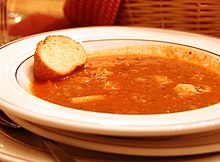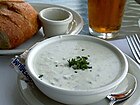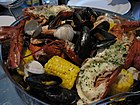Clam chowder
 New England clam chowder. | |
| Type | Chowder |
|---|---|
| Place of origin | United States |
| Region or state | New England Massachusetts |
| Invented | 18th century[1][2] |
| Main ingredients | Clams, broth, butter, potatoes and onions |
| Variations | New England clam chowder also known as Boston clam chowder, Manhattan clam chowder, Rhode Island clam chowder, others |
Clam chowder is any of several chowder soups containing clams and broth. In addition to clams, common ingredients include diced potatoes, onions, and celery. Other vegetables are not typically used, but small carrot strips or a garnish of parsley might occasionally be added primarily for color. A garnish of bay leaves adds both color and flavor. It is believed that clams were used in chowder because of the relative ease of harvesting them.[3] Clam chowder is usually served with saltine crackers or small, hexagonal oyster crackers.
The dish originated in the Eastern United States, but is now commonly served in restaurants throughout the country, particularly on Fridays when American Catholics traditionally abstained from meat. Many regional variations exist, but the two most prevalent are New England or "white" clam chowder and Rhode Island / Manhattan or "red" clam chowder.
History

The earliest-established and most popular variety of clam chowder, New England clam chowder, was introduced to the region by French, Nova Scotian, or British settlers, becoming common in the 18th century. The first recipe for another variety, Manhattan clam chowder, known for using tomatoes and its consequently distinctly red coloring, was published in 1934. In 1939, the New England state of Maine debated legislation that would outlaw the use of tomatoes in chowder, thereby essentially prohibiting the "Manhattan" form.[1]
Primary variants and styles
Since the popularity of New England clam chowder spread throughout the United States in the 19th and 20th centuries, many other regions have introduced their own, local twists on the traditional recipe.
Delaware clam chowder
This variety typically consists of pre-fried cubed salt pork, salted water, potatoes, diced onions, quahog clams, butter, salt, and pepper. This variety was more common in the early and mid-20th century, and likely shares most recent common ancestry with New England clam chowder.
Hatteras clam chowder
Served throughout North Carolina's Outer Banks region, this variation of clam chowder has clear broth, bacon, potatoes, onions, and flour as a thickening agent. It is usually seasoned with copious amounts of white and/or black pepper, and occasionally with chopped green onions or even hot pepper sauce.
Long Island clam chowder
Long Island clam chowder is a variant that is part New England-style and part Manhattan-style, making it a creamy tomato clam chowder. The name is a geographical pun, noting that the location of Long Island, just like the recipe, is about halfway between Manhattan and New England.[4] This variant is popular in many small restaurants across Suffolk County, New York.[5]
Manhattan clam chowder

Manhattan clam chowder has red broth, which is tomato-based. The addition of tomatoes in place of milk was initially the work of Portuguese immigrants in Rhode Island, as tomato-based stews were already a traditional part of Portuguese cuisine.
In the 1890s, this chowder was called "Fulton Fish Market clam chowder" and "New York City clam chowder." Manhattan clam chowder was referenced in Victor Hirtzler's "Hotel St. Francis Cookbook (1919).[citation needed]
Minorcan clam chowder
Minorcan clam chowder is a spicy traditional version found in Florida restaurants near St. Augustine and the northeast corner of Florida. It has a tomato broth base, with datil pepper: an extremely hot chili comparable to the habanero. The datil is believed to have been brought to St. Augustine by Menorcan settlers in the 18th century, and tradition holds among their descendants that it will only thrive and grow in two places: Menorca, Spain and St. Augustine, Florida.[6]
New England clam chowder
New England clam chowder, occasionally referred to as Boston Clam Chowder in the Midwest, is a milk or cream-based chowder, and is often of a thicker consistency than other regional styles, even though traditionally it is rather thin (with many late 19th and early 20th century recipes using condensed milk as the base). It is commonly made with potatoes, onion, and clams.
New England clam chowder is usually accompanied by oyster crackers. Crown Pilot Crackers were a popular brand of cracker to accompany chowder, until the product was discontinued in 2008. Crackers may be crushed and mixed into the soup for thickener, or used as a garnish.[7]

Rhode Island clam chowder
One claim to traditional Rhode Island clam chowder is a red chowder with a tomato broth base and potatoes but - unlike Manhattan style - Rhode Island's clam chowder has no chunks of tomato and does not contain other vegetables. Its origins are reportedly Portuguese and it was commonly served with clamcakes.
Another tradition has a clam chowder made with clear broth which is common along the New England coast from eastern Connecticut to southwestern Rhode Island. In southwestern Rhode Island, it is sometimes called "South County Style" referring to the colloquial name of Washington County, Rhode Island, where it allegedly originated. In other parts of New England, it contains quahogs, broth, potatoes, onions, and bacon.
Clear clam chowder
Clear clam chowder is a clam chowder that is based on clear broth and is a clear color and has a thinner consistency thinner then the Manhattan or the New England styles and sometimes has mussels or steamers along with clams.
Other variations
Some restaurants serve their own unique clam chowders that do not fall into any specific categories. For example:
- Clam chowder is sometimes served in sourdough bread bowls, especially in San Francisco, where sourdough bread is popular with tourists, and has been considered a signature dish since 1849.[8][9]
- Except for the substitution of smoked haddock for clams, chowder is similar to the traditional Scots cullen skink.
- Fish chowder is similar to clam chowder except that filleted fish, often cod, is substituted for the clams.
- In Pacific Northwest cuisine, a salmon chowder is also popular.[10]
See also
References
- ^ a b Correa, Cynthia. "A Brief History of Clam Chowder". Eater. eater.com. Retrieved August 21, 2016.
- ^ "Manhattan Clam Chowder vs. New England Clam Chowder". Retrieved August 21, 2016.
- ^ "History of Chowder, History of Clam Chowder, History of Fish Chowder". Whatscookingamerica.net. Retrieved December 1, 2007.
- ^ "Long Island Clam Chowder: Secret Blend Slowly Catching On". Long Island News from the Long Island Press. Retrieved October 29, 2015.
- ^ Louis Imbroto. "Long Island clam chowder?". Young Island. Retrieved October 29, 2015.
- ^ Jean Andrews. "A Botanical Mystery: The Elusive Trail of the Datil Pepper to St. Augustine: Jean Andrews". Jstor.org. JSTOR 30148816.
{{cite journal}}: Cite journal requires|journal=(help)(subscription required) - ^ Oliver, Sandy (April 2008). "The Crown Pilot Cracker Escapade: 11 Years Later". The Working Waterfront.
{{cite journal}}: Cite journal requires|journal=(help) - ^ "Bay City Guide : City Sights". Archived from the original on November 2, 2007. Retrieved December 1, 2007.
- ^ "Square One Titles". Squareonepublishers.com. Archived from the original on February 4, 2012. Retrieved December 1, 2007.
{{cite web}}: Unknown parameter|deadurl=ignored (|url-status=suggested) (help) - ^ Jasper White (2000). 50 Chowders. Scribner. p. 105. ISBN 0684850346.



